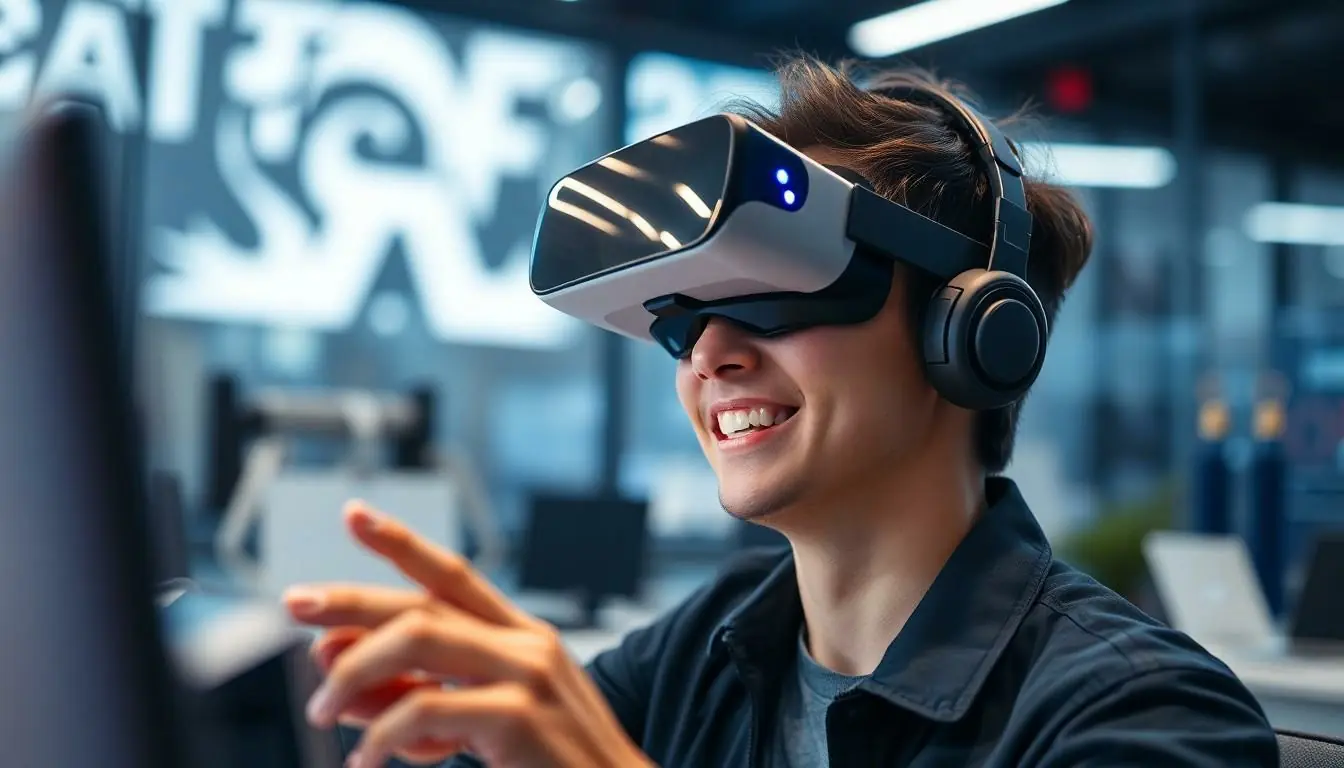Table of Contents
ToggleIn a world where multitasking is the norm and distractions lurk around every corner, tracking eye movements using wearables is like having a personal assistant for your vision. Imagine knowing exactly where your gaze lands while scrolling through your favorite social media feed or binge-watching the latest series. It’s not just about looking cool with tech on your face; it’s about unlocking insights into attention, engagement, and even productivity.
These nifty gadgets can reveal what truly captures our interest and what just makes us yawn. Whether it’s enhancing user experience in gaming or improving focus during work, the potential is vast. So, why not embrace this eye-opening technology? With wearables on the rise, tracking eye movements might just become the next big thing in personal analytics—because who wouldn’t want to know if they’re staring at their boss or that delicious slice of pizza?
Importance Of Tracking Eye Movements
Tracking eye movements plays a crucial role in understanding user behavior and enhancing interactions with technology. This technology has implications across diverse fields, providing insights that improve productivity and engagement.
Benefits In Various Fields
Eye movement tracking enhances areas such as education, healthcare, and marketing. In education, it helps assess student focus during lessons, indicating the effectiveness of teaching methods. Healthcare professionals can monitor patient responses in real-time, leading to improved treatment strategies. Marketing teams analyze engagement with ads, optimizing designs based on consumer gaze patterns.
Impact On User Experience
Using wearables for eye movement tracking significantly elevates user experience. Gamers can enjoy tailored gaming environments, adjusting challenges based on where players focus. In virtual reality, eye tracking creates immersive experiences by making interactions more intuitive. It simplifies navigation in mobile apps, ensuring users engage with content that matters most to them.
How Wearable Technology Works

Wearable technology enables eye movement tracking through various devices that integrate advanced technologies. These devices provide real-time data and insights, enhancing user experiences across multiple settings.
Types Of Wearable Devices
Smart glasses represent a primary category of wearable devices. These glasses often come equipped with built-in cameras and sensors to monitor eye movements. Wearable headsets also play a crucial role, especially in virtual reality environments, where they track gaze direction for immersive experiences. Fitness trackers, though primarily aimed at health monitoring, increasingly incorporate eye-tracking features to analyze attentional patterns during physical activities. Lastly, smart contact lenses are under development, designed to offer discreet eye-tracking capabilities without compromising everyday comfort.
Mechanisms For Eye Tracking
Infrared light serves as a fundamental component in eye-tracking technology. Sensors emit this light to illuminate the user’s eyes, capturing reflections to analyze movement patterns. High-resolution cameras record eye movements, transmitting data for processing in real time. Specialized algorithms then interpret this data, translating eye movements into actionable insights. Heat maps often visualize gaze patterns, revealing how users interact with different content. By utilizing these mechanisms, wearables provide unparalleled insights into attention, engagement, and behavioral trends.
Applications In Different Industries
Wearable devices that track eye movements have diverse applications across multiple industries, offering enhanced insights and user experiences.
Healthcare Innovations
In healthcare, eye movement tracking technology plays a crucial role in monitoring patient responses. Professionals use wearables to assess cognitive functions and emotional reactions, allowing for personalized treatment plans. For instance, analyzing gaze patterns can help in evaluating the effectiveness of therapeutic interventions. These tools also aid in diagnosing conditions such as autism and ADHD by providing data on attention spans. Remote monitoring through these devices fosters timely adjustments in care strategies, enhancing patient outcomes and continuous engagement.
Gaming Enhancements
Gaming benefits significantly from eye movement tracking, creating immersive experiences for users. This technology allows game developers to analyze player focus and engagement levels effectively. Players receive tailored content based on their gaze patterns, enhancing overall enjoyment and interaction. Additionally, eye movements can enable intuitive controls, allowing users to navigate games with mere eye direction. As a result, wearables transform gaming environments, making them more engaging and responsive to player dynamics.
Marketing And Advertising Strategies
In marketing, eye movement tracking helps brands understand consumer behavior more deeply. This technology enables teams to analyze engagement with advertisements by studying gaze patterns on various content forms. By optimizing designs based on where consumers focus, brands can enhance ad effectiveness. Moreover, insights gained from eye tracking inform better product placements, ensuring that key features capture attention. Utilizing wearables for this purpose significantly elevates campaign strategies, leading to increased conversion rates and improved audience targeting.
Challenges And Limitations
Eye movement tracking through wearables presents challenges and limitations that must be addressed to enhance its effectiveness and adoption.
Technological Barriers
Complexity in device integration affects user experience. High-resolution cameras and infrared lighting may not function optimally in various lighting conditions, limiting accuracy. Battery life is another concern; prolonged use can drain power quickly. Data processing demands require advanced algorithms that may not be available on all devices. Compatibility issues between different platforms can hinder seamless operation. Additionally, inaccuracies in tracking can lead to erroneous conclusions, impacting the reliability of obtained insights. Continuous advancements in technology remain essential to overcoming these issues and improving user satisfaction.
Ethical Considerations
Privacy concerns arise with continuous eye movement tracking. Users may feel uncomfortable knowing their gaze patterns are monitored. Consent is critical; organizations must ensure clear communication regarding data usage. The potential for misuse of collected data raises ethical questions, particularly in marketing and surveillance contexts. Transparency in data handling practices fosters trust and protects user rights. Furthermore, regulations surrounding data privacy are crucial to ensure ethical compliance. Addressing these ethical considerations shapes the future of wearable eye tracking technology and promotes responsible usage.
Future Prospects
The future of tracking eye movements through wearables shows promising advancements. Researchers continue to improve accuracy and responsiveness, significantly enhancing user experience. Incorporating artificial intelligence boosts adaptability across various contexts. Smart glasses and headsets are progressively incorporating advanced sensors that elevate gaze detection precision. New developments in battery technology support longer usage periods, ensuring consistent performance throughout the day. Manufacturers prioritize seamless integration with other devices, enhancing cross-platform functionality. Enhanced algorithms are also optimizing data analytics, transforming raw gaze patterns into actionable insights.
Advancements In Technology
Innovations in eye-tracking technology improve not only accuracy but also usability in real-world applications. Wearable devices increasingly leverage high-resolution cameras and infrared sensors, which provide clear and precise gaze data. Enhanced algorithms now process eye movement analytics in real-time, elevating the relevance of insights offered to users. Multiple industries benefit from these technological strides as applications become more sophisticated. As the industry matures, user interfaces will also simplify interaction, making this technology more accessible. New smart contact lenses represent the next leap forward, promising even greater convenience for users needing discreet tracking solutions.
Potential For Broader Adoption
Increased awareness among consumers drives interest in eye movement tracking wearables. Many industries recognize the importance of personalized experiences, which positions this technology as crucial for future engagement. Education systems are already exploring eye-tracking tools to assess learning environments, shaping teaching methodologies. Healthcare providers see significant opportunities in using eye-tracking devices for enhanced patient monitoring and treatment personalization. Marketing teams aim to leverage insights from consumer gaze data to refine advertising strategies. The potential for broader adoption lies in addressing ethical concerns while ensuring transparency in data handling practices. As confidence grows in privacy protection, usage across sectors will likely expand, leading to widespread acceptance.
The future of eye movement tracking through wearables holds immense promise across various sectors. As technology advances and ethical considerations are addressed, users can expect more personalized and engaging experiences. This innovation not only enhances interactions in gaming and marketing but also revolutionizes education and healthcare by offering deeper insights into behavior and focus.
With ongoing improvements in accuracy and data processing, the integration of eye tracking into everyday life is set to become more seamless. As awareness grows and transparency in data practices is prioritized, the widespread adoption of these devices will likely transform how individuals engage with their environments, ultimately enriching their daily experiences.




